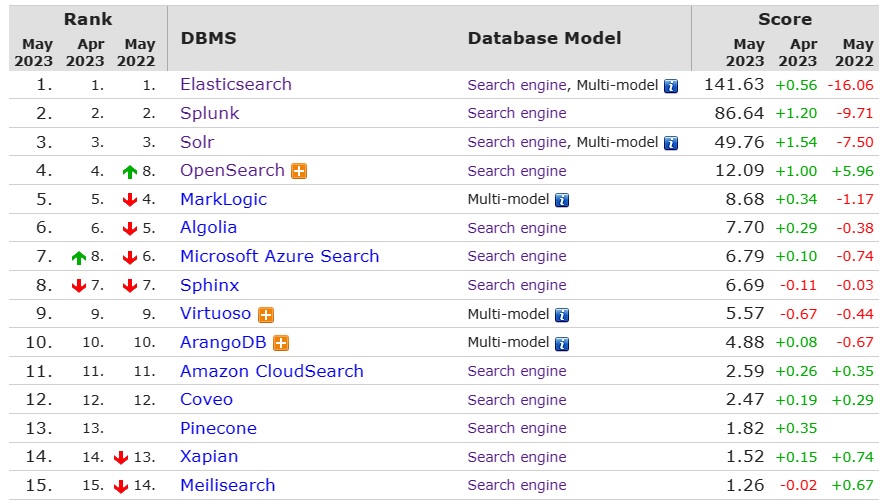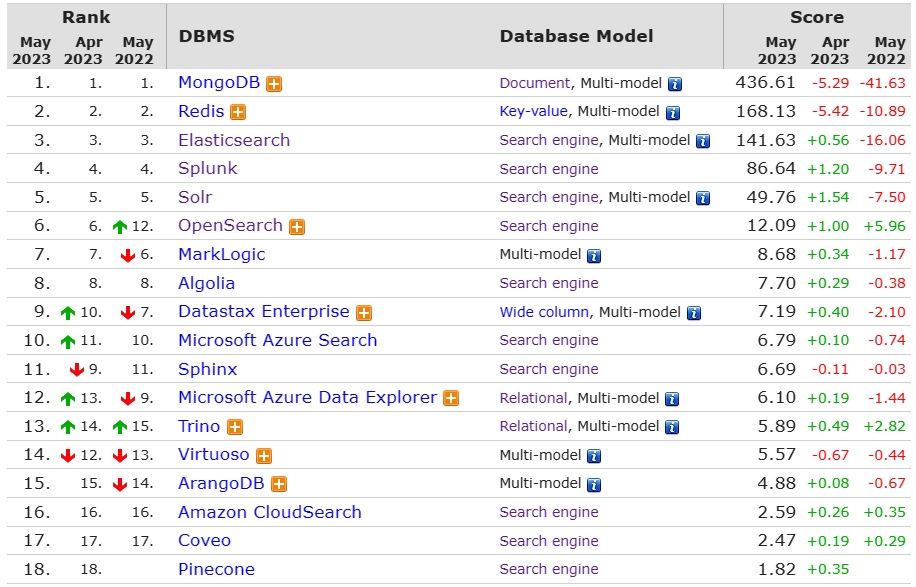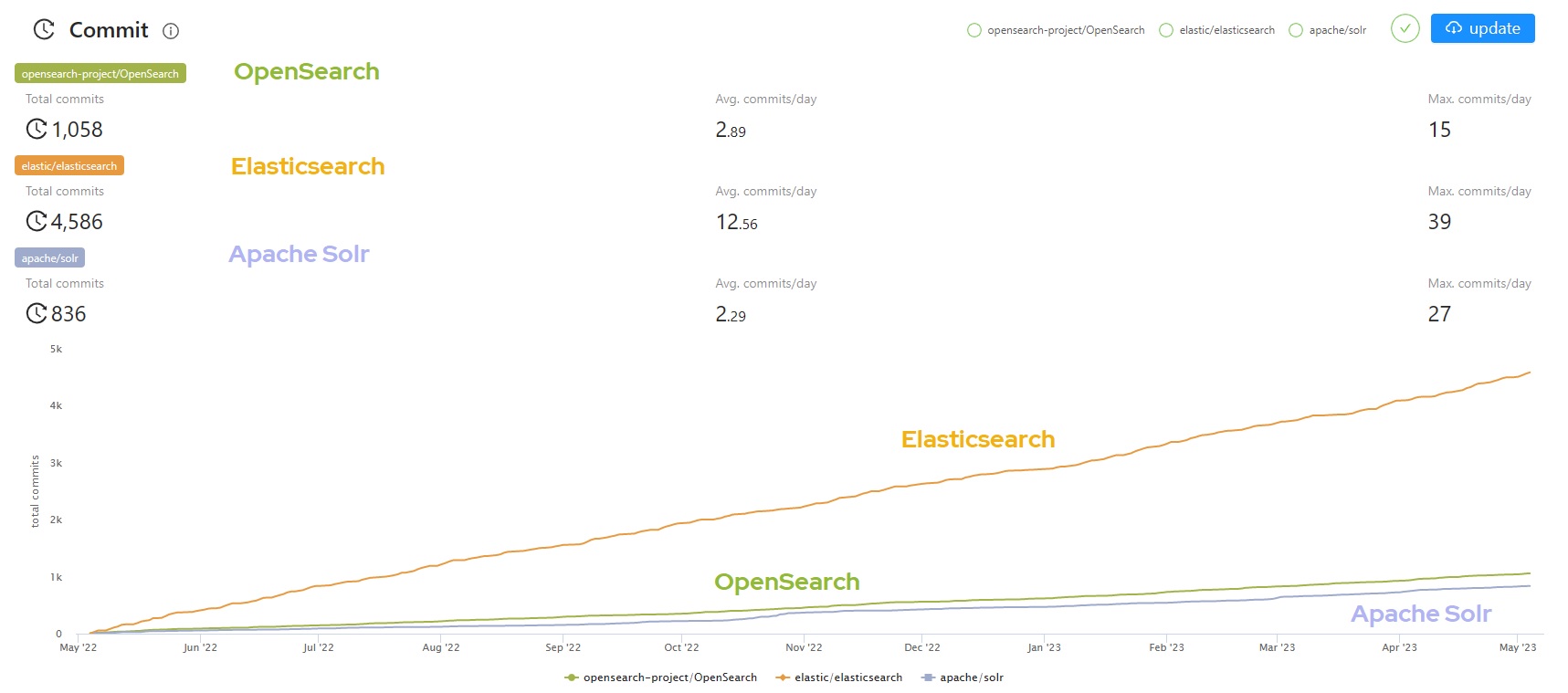

Graham Gillen
Objective popularity rankings to help you choose a Search Engine in 2023
If you want to add a search engine to your website, which should you use? What if you are building an application that embeds search?
Analyst rankings like Gartner, Forrester and others may be helpful, but not completely objective. While they often provide in-depth analysis and attempt to be transparent, they take a long time to publish, only come out once a year (or less) and are often out of date by the time they are published. They also are meant as a guide for commercial solutions, and so, they omit pure open-source solutions like Solr.
DB-Engines as an objective ranking of search engine popularity for 2023
One additional source you should include in your search is the DB-Rankings listing on Search Engines, whose aim is to objectively rank the popularity of search engines.


Database Model – Search engine and Multi-model
One thing we should explain in the DB-Rankings. As its name implies, the website analyzes and ranks database platforms and technologies. A traditional model would be Relational DBMS. When DB-Rankings refers to a search engine model, it defines these technologies as NoSQL database management systems dedicated to the search for data content. Search engines tools must also offer the following features:
- Support for complex search expressions
- Full text search
- Stemming (reducing inflected words to their stem)
- Ranking and grouping of search results
- Distributed search for high scalability
Search engines that have database capabilities beyond this are tagged in the rankings as “multi-model.” For example, Elasticsearch and Solr are also listed as having Spatial DBMS capabilities suitable for search in GIS applications.
Scoring Methodology for DB-Engines 2023 Search Engine Rankings
The DB-Engines scoring methodology is transparent and relatively easy to understand. We’ve summarized it below.
The DB-Engines Ranking generates a score meant to measure popularity of a technology platform. This is measured by quantifying the following parameters:
- Number of mentions of the system on websites, measured as number of results in search engines queries (from Google and Bing.)
- General interest in the system, based on frequency of searches in Google Trends.
- Frequency of technical discussions about the system, a count of questions and interested users on the IT-related Q&A sites like Stack Overflow and DBA Stack Exchange.
- Number of job offers in which the system is mentioned, as measured on leading job search engines Indeed and Simply Hired.
- Number of mentions in profiles in professional networks. In this case, LinkedIn, the top global network.
- Relevance in social networks, based on the number of Twitter tweets in which the system is mentioned.
DB-Engines goes on to detail the statistical approach used to ensure consistency in measuring the scores over time, as well as consistency between analyzing the difference in popularity scores between any two systems. They also caution that the popularity score is a relative value and should only be interpreted in comparison to other systems using the same scoring methodology.
It should be noted that the rankings are a measure of the popularity of a search engine, and not an evaluation of the technologies’ technical merits, costs, or fit for your specific situation. Nevertheless, it’s one more useful metric to consider, especially in the early stages of choosing a search engine for your search-based application.
And popularity as defined by the DB-Engines Ranking does not measure the number of installations of the systems, or their use within IT systems. However, an increase or decrease in scores over time – based on factors like discussions or job offers – may be an early indicator of how a technology is trending.
Observations from 2023 rankings of the top search engines
Elasticsearch
Still the Big Dog in search right now. Debuting as an Apache-licensed open source search engine, Elasticsearch saw its popularity soar from 2014 to 2019. The popularity score has leveled off as the distribution model has tightened up to a Server Side Public License (SSPL). But Elasticsearch remains hugely popular, including its availability as a service on the top cloud providers today. Like many of the search engines on this list, Elasticsearch was either based on or inspired by Apache Lucene.
The search engine application areas that Elasticsearch is known for (as described by parent company Elastic) include Enterprise Search, Observability, and Security.
- Enterprise Search covers traditional applications like website, ecommerce, and intranet search.
- Observability covers analytics and dashboard use cases where Elasticsearch is paired with Logstash and Kibana (known as the ELK or Elastic Stack).
- Security is a specific case of Observability where Elasticsearch (and the Elastic Stack) are deployed as a Security Information and Event Management (SIEM) solution.
Splunk
Founded in 2003, Splunk has always been a proprietary commercial platform (not open source), though it drew some inspiration from Apache Lucene. Splunk basically helped define the market analogous to Elastic Observability and Security use cases. It dominates this space, although Elastic has made significant competitive inroads into Splunk’s markets. Splunk is usually not deployed in search applications with a lot of text or unstructured data.
Solr
The Grand Dame of open-source search engines, Solr emerged in 2003 and became hugely popular amongst search developers as well as commercial search application developers. While it still ranks third in the DB-Rankings for search engines, its popularity peaked in 2015 – mostly likely a victim of the growing popularity of Elasticsearch and the ELK Stack. There were failed attempts to create something similar to the ELK Stack using Solr (e.g. Banana – which failed to compete with Kibana).
Solr is still deployed on many websites and in many applications because it’s proven, and it simply just works. But over time, some developers may be concerned that it can’t keep pace with the latest innovations, despite recently released features for vector search and neural search. The rate of new Solr implementations may eventually be outpaced by migrations to alternatives.
OpenSearch
OpenSearch is a possible successor to Solr as the most popular search engine released on the free, “pure” open-source Apache 2.0 software license model. OpenSearch was started in 2021 as a branch from Elasticsearch, just prior to the change in Elastic’s licensing model. This caused some considerable friction between AWS (a major backer of OpenSearch) and Elastic, those the feud has been quiet, of late.
While its popularity score is still much lower than Solr (and dwarfed by Elasticsearch), OpenSearch shows momentum, having jumped from #8 to #4 in the DB-Rankings scoring in the last year. OpenSearch also has the advantage of including components like OpenSearch Dashboard, which is similar to Elastic Kibana. This allows OpenSearch to be a candidate for all three Elasticsearch use cases – enterprise search, observability, and security. So OpenSearch is a solution to keep a watch on in the next 24 months.
Pinecone
While Pinecone is only #13 in the DB-Rankings, we mention it because it was the first commercially available platform focused primarily on vector search, which is a key capability that enables AI-powered or neural search applications.
Rather than traditional search indexes built for keyword search, vector databases can contain entire paragraphs generated from millions of pages of documents, and represented as numerical, n-dimensional vectors. Instead of keyword search, which is based on exact matches for words (or at best synonyms), vector search applications can take a lengthy natural language query and then search in the vector database for paragraphs that have the same meaning as the query.
Pinecone recently received another $100M investment and a $750m valuation. While this reflects investor excitement in the growth of vector databases and vector search, Pinecone acknowledges that traditional search still works best for many search applications, and that hybrid search may be the best architecture for the foreseeable future.
MongoDB: a new search engine platform to consider?
In playing with the DB-Rankings tool, we noted a checkbox marked “include secondary database models.” When we clicked on this box, we were surprised by the results, which are noteworthy. MongoDB comes in at #1, with a score almost three times that of Elasticsearch.


MongoDB and MongoDB Atlas Search
While MongoDB is not known as a traditional search engine, it is extremely popular and is viewed by DB-Engines as a data platform with multi-model capabilities including as a document store, a spatial DBMS, and a time series DBMS. DB-Engines even credits MongoDB for supporting search-engine-like data models, though it doesn’t rank highly purely on that capability. But that may change soon.
With the release of MongoDB Atlas Search, MongoDB is taking search very seriously – especially full-text document search. If you are building an application that needs a NoSQL store AND top-notch search capabilities, then MongoDB has to be a strong contender, if not the default choice.
We think this is a big enough development that Pureinsights has partnered with MongoDB to leverage Atlas Search and develop cloud-based applications on the Atlas platform. Look for more on this in future blogs!
Other ways to rank search engine popularity
Finally, we wanted to point out one other resource that complements everything we’ve presented here – from analyst reports to DB-Rankings. And that’s statistics from GitHub.
As a code repository for open-source projects like Solr, Elasticsearch and OpenSearch, GitHub can provide statistics on project pull requests (contributions), commits (approved contributions), issues and other relevant stats.
GitHub has an API that allows developers to get statistics for the different repositories. For curious non-developers, you may have to sift through several pages of Google search, but we did find this page to be useful – Github Statistics (vesoft-inc.github.io). Incidentally, the page graphs are powered by the Nebula Graph project in GitHub. However, these statistics have not been validated or audited by other sources. They do help with a big-picture comparison of these three search engines, however.


Final thoughts on 2023 Search Engine Rankings
Choosing which search engine to use for your website or search-based application can be challenging. The purpose of this blog was to highlight DB-Rankings as an objective tool to compare search engines. By no means should this be the only tool that you use in picking a search engine to use. Neither should you just lean on the crutch of expensive analyst reports.
But the sheer number of resources available can be overwhelming. Like for many important decisions – finding a real estate agent, car mechanic, plumber, or investment advisor – we find that word of mouth from someone you know and trust is always important.
Pureinsights has worked with virtually all of the top search engine platforms, and because we don’t resell any of them, we always try to find the solution that best meets our customers’ technical and business requirements. We’re here to help and can usually put you in touch with another customer who has implemented the solution you have in mind.
As always, please CONTACT US if you have any comments or questions, or to request a free consultation to discuss your ongoing search and AI projects.